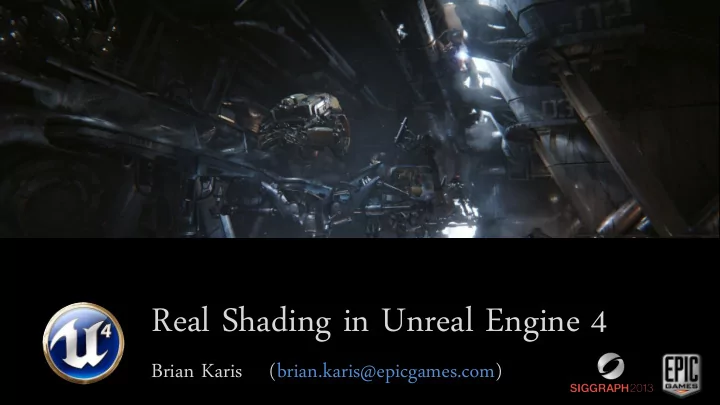

Real Shading in Unreal Engine 4 Brian Karis (brian.karis@epicgames.com)
Goals • More realistic image • Material layering – Better workflow – Blended in shader • Timely inspiration from Disney – Presented in this course last year
Overview • Shading model • Material model • Lighting model
Shading Model
Diffuse BRDF • Lambert – Saw little effect of more sophisticated models Lambert Burley
Specular BRDF • Generalized microfacet model – Compared many options for each term – Use same input parameters 𝑔 l, v = 𝐸 h 𝐺(l, h)𝐻 l, v, h 4(n ⋅ l)(n ⋅ v)
𝑔 l, v = 𝐸 h 𝐺(l, h)𝐻 l, v, h Specular distribution 4(n ⋅ l)(n ⋅ v) • Trowbridge-Reitz (GGX) – Fairly cheap – Longer tail looks much more natural GGX Blinn-Phong
𝑔 l, v = 𝐸 h 𝐺(l, h)𝐻 l, v, h Geometric shadowing 4(n ⋅ l)(n ⋅ v) • Schlick – Matched to Smith – Cheaper, difference is minor – Uses Disney’s roughness remapping* n ⋅ v 𝐻 𝑇𝑑ℎ𝑚𝑗𝑑𝑙 (v) n ⋅ v 𝐻 𝑇𝑛𝑗𝑢ℎ (v) 𝛽 = 0.1 𝛽 = 0.5 𝛽 = 0.9
𝑔 l, v = 𝐸 h 𝐺(l, h)𝐻 l, v, h Fresnel 4(n ⋅ l)(n ⋅ v) • Schlick – Approximate the power Identical for all practical purposes
Image-based lighting : Problem • Only use single sample per environment map • Match importance-sampled reference 𝑂 𝑀 𝑗 l 𝑙 𝑔 l 𝑙 , v 𝑑𝑝𝑡 𝜄 l 𝑙 ≈ 1 𝑀 𝑗 l 𝑔 l, v 𝑑𝑝𝑡 𝜄 l 𝑒l 𝑂 𝑞 l 𝑙 , v 𝑙=1 𝐼
Image-based lighting : Solution • Same as Dimitar’s : split the sum • Pre-calculate both parts 𝑂 𝑂 𝑂 𝑀 𝑗 l 𝑙 𝑔 l 𝑙 , v cos 𝜄 l 𝑙 𝑔(l 𝑙 , v) cos 𝜄 l 𝑙 1 1 1 𝑂 ≈ 𝑂 𝑀 𝑗 l 𝑙 𝑂 𝑞 l 𝑙 , 𝑤 𝑞(l 𝑙 , v) 𝑙=1 𝑙=1 𝑙=1
Pre-filtered environment map • 1 st sum stored in cubemap mips – Pre- filter for specific roughness’s – Fixed distribution, assume n = v – Loses stretched highlights 𝑂 1 𝑂 𝑀 𝑗 l 𝑙 ≈ Cubemap. Sample(r, mip) 𝑙=1
Environment BRDF • 2 nd sum stored in 2D lookup texture (LUT) Roughness cos 𝜄 v 𝑂 𝑔(l 𝑙 , v) cos 𝜄 l 𝑙 1 𝑂 = LUT. r ∗ 𝐺 0 + LUT. g 𝑞(l 𝑙 , v) 𝑙=1
Importance-sampled reference
Split sum approximation
Complete approximation (n=v)
Importance-sampled reference Split sum approximation Complete approximation (n=v)
Material Model
Material model • BaseColor – Single color • Metallic Metallic 0 to 1 – Less chance of error • Roughness Metal with roughness 0 to 1 – Very clear in its meaning • Cavity – Used for small scale shadowing Non-metal with roughness 0 to 1
Material model lessons • Specular parameter is confusing – Not really needed – Replaced with Cavity Infiltrator Now Samaritan BaseColor BaseColor DiffuseColor Metallic Metallic SpecularColor Specular Roughness SpecularPower Roughness Cavity
Material layering • TODO : anotherimage
Material layering tools • Added layers to our node graph based material editor – Layers use existing material function feature – Added material attributes struct • Layer workflow similar to previous texture workflow
Material layering
Material layering
Lighting Model
Inverse square falloff Old falloff Inverse square
Area Lights
Area light requirements • Consistent material appearance – Energy evaluated with diffuse BRDF and specular BRDF should match • Approaches point light model as solid angle approaches zero – Don’t want to lose any aspect of our shading model • Fast enough to use everywhere – Otherwise artists will bias roughness
Specular D modification • Widen specular distribution by light’s solid angle – We presented this last year • Problems – Glossy surfaces don’t look glossy anymore
Reference Specular D modification
Representative point • Pick one representative point on light source shape • Shading model can be used directly • Point with largest contribution is a good choice • Approximate using smallest angle to reflection ray
Sphere lights • Irradiance identical to point light – If sphere above horizon • Closest point between ray and sphere – Approximates smallest angle
Sphere light energy conservation • Specular distribution has been widened by light’s solid angle – We already have an approximation for this using “Specular D modification” – Only use normalization term – Divide out original normalization, multiply in new
Reference Representative point
Representative point applied to Tube Lights
In the course notes • Tons of extra stuff – Importance sampling code – Area light formulas – Lots of math
Thanks • Epic – Rendering team – All the artists making me look good • Special thanks to Sébastien Lagarde • Stephen Hill and Stephen McAuley for valuable input
Recommend
More recommend